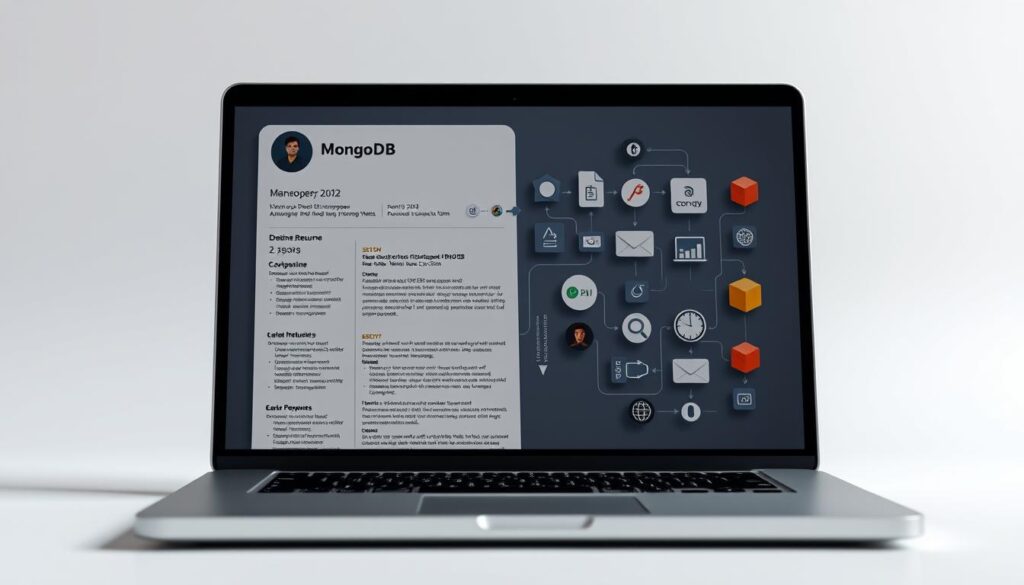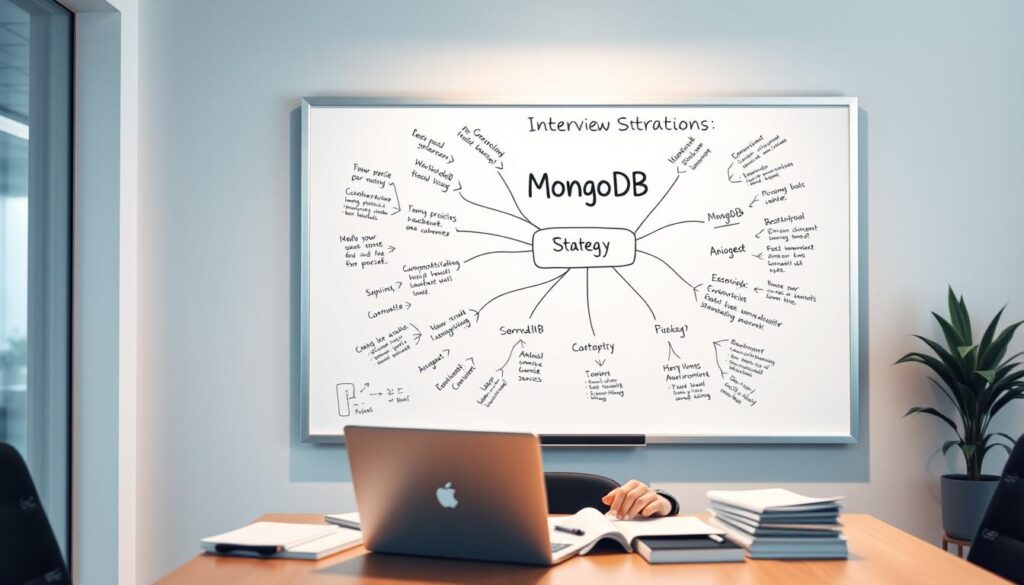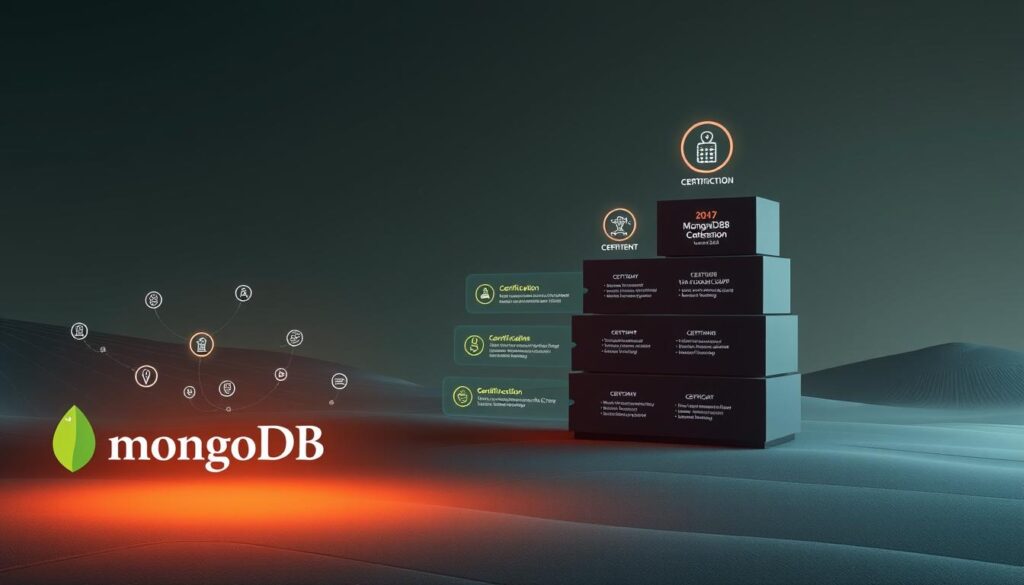Over 30,000 companies now use MongoDB for mission-critical applications – yet 67% of hiring managers report struggling to find qualified candidates. This document-oriented database platform powers everything from mobile apps to AI systems, creating urgent demand for skilled professionals.
New developers often face a paradox: employers want proven experience, but you need opportunities to gain that experience. Traditional job searches can feel like shouting into a void, especially when competing against seasoned database specialists.
RoboApply’s Auto Apply feature changes the game. This AI-driven tool analyzes job descriptions across platforms, tailoring your applications to match specific MongoDB requirements. With one click, you can submit polished, personalized materials to hundreds of relevant openings – no manual tweaking required.
Key Takeaways
- MongoDB’s document-based structure dominates modern app development
- Practical projects outweigh formal experience for entry-level roles
- Certifications demonstrate core competencies to hiring teams
- Resume optimization targets database-specific keywords
- Automated tools multiply interview opportunities efficiently
Building expertise starts with hands-on practice. Create a portfolio showcasing real-world scenarios like schema design or aggregation pipelines. Pair these demonstrations with targeted preparation for common technical assessments – the path to your first MongoDB role begins here.
Understanding MongoDB in the Modern Job Market
Companies managing unstructured data increasingly favor document-based systems over rigid relational models. MongoDB’s JSON-like structure enables developers to store information in flexible formats – a key reason 43% of enterprises now prioritize it for new projects. This shift creates unique opportunities for those entering the field.
Unlike traditional databases requiring predefined schemas, MongoDB adapts to evolving data needs. Startups scaling rapidly and enterprises handling real-time analytics rely on its ability to manage diverse applications. As one tech lead noted:
“Our migration to MongoDB cut development time by 30% – it’s become our backbone for customer-facing systems.”
Job openings span industries from e-commerce to healthcare. Entry-level roles often focus on:
- Designing efficient document structures
- Optimizing query performance
- Integrating with cloud-based systems
Understanding these priorities helps tailor your learning path. For example, mastering aggregation pipelines directly aligns with common database developer roles requiring data transformation skills.
The platform’s scalability makes it ideal for mobile app backends and content management tools. By focusing on practical implementations – like building a product catalog or user analytics dashboard – you demonstrate value even without formal experience.
Fundamental MongoDB Skills for Developers
Modern data management demands flexibility – a key reason organizations adopt NoSQL systems. These databases handle evolving information structures that traditional tables can’t support efficiently.
Overview of NoSQL Databases
NoSQL databases excel at managing unstructured or semi-structured data, a common need in web applications and real-time analytics. Unlike rigid SQL schemas, they allow dynamic adjustments to document formats. This adaptability speeds up development cycles and simplifies scaling.
For example, an e-commerce platform using MongoDB can easily add product attributes without altering existing records. Mastery of these essential MongoDB skills shows employers you understand modern data challenges.
Key MongoDB Concepts and Terminology
Every MongoDB document stores data as BSON – a binary JSON format supporting strings, numbers, arrays, and nested structures. Consider these core elements:
- Collections: Groups of related documents (similar to SQL tables)
- _id Field: Mandatory unique identifier for each document
- Data Types: 16 supported formats including timestamps and geospatial coordinates
Practice creating collections with varying document structures. A social media app might store user profiles with embedded posts, while a logistics system tracks shipments with nested location history. This hands-on approach builds confidence for database administration roles requiring schema design expertise.
Building a Strong MongoDB Resume with RoboApply
Crafting a resume that stands out in database roles requires strategic keyword placement and clear skill demonstration. Traditional templates often miss the mark for technical positions, leaving qualified candidates overlooked.

Transform Your Application with Smart Tools
RoboApply’s AI analyzes thousands of successful resumes to identify patterns hiring managers prioritize. The system suggests industry-specific verbs like “optimized” and “architected” that resonate in data-driven roles.
Highlight these elements to strengthen your profile:
- Relevant coursework in data modeling or cloud systems
- Personal projects demonstrating query optimization
- Certifications like MongoDB University’s Developer Path
The platform’s keyword density analyzer ensures your resume matches job descriptions precisely. For backend roles, it might emphasize sharding strategies. Analytics positions would highlight aggregation pipeline expertise.
Quantify achievements using RoboApply’s metrics builder. Instead of “Built a project,” write “Improved query response time by 40% through index optimization.” Specific numbers prove your impact better than generic statements.
Create multiple resume versions in minutes. Tailor each for specific applications while maintaining core technical truths. This approach helps candidates adapt to varying role requirements without starting from scratch.
Leveraging RoboApply for Interview Preparation
Technical screenings often feel like high-stakes exams. RoboApply’s coaching tools transform anxiety into actionable strategy through targeted practice and system optimization.
Interview Coaching and ATS Optimization
The platform’s AI simulates real-world scenarios you’ll face during assessments. Practice explaining sharding strategies or debugging aggregation pipelines while receiving instant feedback on clarity and technical accuracy. These mock sessions adapt to your learning pace, focusing on weak spots like query optimization or index management.
RoboApply’s ATS scanner analyzes your resume against employer-specific criteria. It suggests improvements like adding “BSON document design” or “replica set configuration” to match job descriptions. This optimization boosts visibility in automated screening systems, increasing callback rates by up to 3x according to user data.
Structure responses using the STAR method during practice sessions. For example:
- Situation: “My e-commerce project required real-time inventory updates”
- Action: “Implemented change streams to track modifications”
- Result: “Reduced latency by 25% across 10,000 concurrent users”
The system tracks progress across mock interviews, highlighting areas needing reinforcement. Pair these insights with behavioral strategies from front-end roles to create well-rounded answers. You’ll learn to articulate technical concepts confidently while showcasing problem-solving skills hiring teams value.
How to Get MongoDB Developer Interviews Without Experience
Breaking into database roles requires proving competence through visible results. Start by creating three portfolio projects that solve real data challenges – an inventory tracker using document nesting, a user analytics dashboard with aggregation pipelines, and a content management system with optimized queries.

Contribute to open-source projects requiring schema design or sharding implementations. GitHub repositories like “Awesome MongoDB” list beginner-friendly tasks. One hiring manager shared:
“We prioritize candidates who show initiative through collaborative coding – it demonstrates job-ready skills.”
Engage with MongoDB communities on Reddit and Stack Overflow. Share solutions to common issues like index optimization or replica set configurations. These interactions build professional connections while showcasing your technical grasp.
Use RoboApply’s filters to target companies offering mentorship programs. Growing tech startups often value adaptability over years of experience. Highlight rapid learning capabilities by documenting your progress – write case studies explaining how you improved query performance or scaled document storage.
Prepare for technical discussions by practicing with real interview questions. Focus on explaining concepts like ACID properties versus eventual consistency. Demonstrate problem-solving flow:
- Describe a project requiring complex operations
- Outline your approach to schema design
- Share measurable outcomes using specific data points
Showcasing Projects and Hands-On MongoDB Experience
Portfolios speak louder than resumes in database roles. Start with an expense tracker that uses MongoDB’s insert() and find() operations. Track daily purchases as individual documents with categories, amounts, and timestamps. Add aggregation pipelines to calculate monthly spending patterns – real-world data manipulation employers value.
Build a content management system showcasing flexible schemas. Let users create articles with varying metadata fields. Demonstrate update() operations for editing content and delete() methods for archiving posts. This proves you understand dynamic collection management.
Develop a social platform with nested document structures. Store user profiles containing arrays of comments and reactions. One hiring manager noted:
“Candidates who visualize data relationships through projects stand out immediately.”
Deploy projects to MongoDB Atlas using free-tier accounts. Include performance benchmarks comparing indexed versus non-indexed queries. Document design choices in README files – Node.js developer resume examples show effective project documentation techniques.
Add unit tests verifying CRUD operations work as intended. Measure query response times under different loads. These details demonstrate production-ready thinking beyond basic database interactions.
Mastering the Basics Through Practice and Coursework
Developing core competencies requires combining formal education with applied practice. MongoDB University offers free courses that transform theoretical knowledge into job-ready abilities through interactive labs and real-world scenarios.

Strategic Skill Development Resources
Begin with the MongoDB Developer Path certification program. This six-course series covers document structure design, query optimization, and index management. Each module includes hands-on exercises using actual data operations from e-commerce and IoT applications.
Supplement coursework with daily coding challenges. Platforms like HackerRank feature problems mirroring technical assessments:
- Schema design for user authentication systems
- Aggregation pipeline creation for sales reports
- Index optimization for faster search queries
Configure a local development environment using MongoDB Community Server. Practice creating collections with varying document structures – experiment with nested arrays in social media profiles or geospatial data in delivery tracking systems. One certified instructor advises:
“Students who complete 30 minutes of daily hands-on practice demonstrate 40% better retention of core concepts.”
Engage with MongoDB’s official forums to troubleshoot challenges. Analyze discussion threads about replica set configurations or sharding strategies. These interactions deepen understanding while building professional networks critical for career growth.
Preparing for Technical Questions and Live Coding Challenges

Technical interviews test your ability to translate concepts into working solutions. Employers want to see how you approach database design challenges and optimize real-world queries. Focus on demonstrating both technical knowledge and problem-solving methodology.
Common MongoDB Interview Questions
Expect foundational questions about document-based architecture. A frequent starter: “Compare MongoDB’s schema flexibility with SQL databases.” Highlight horizontal scaling capabilities and JSON-like structures. Practice explaining replica sets in simple terms:
- Three-node configurations for fault tolerance
- Automatic failover during hardware issues
- Read/write operations distribution
Another common interview topic: indexing strategies. Prepare to discuss when to use compound indexes versus text indexes. Use examples like e-commerce search filters needing multiple field optimizations.
Practical Coding Examples and Scenarios
Live coding tests often involve building aggregation pipelines. You might receive a dataset of sales transactions and need to calculate quarterly profits by region. Structure your approach:
- Filter documents by date range
- Group results by geographical location
- Sum revenue while deducting costs
For nested data tasks, practice querying arrays in user profiles. A sample challenge: “Find all accounts with at least two verified email addresses.” Use $size and $elemMatch operators to demonstrate precision.
Pair these exercises with behavioral strategies from front-end roles to showcase full-stack awareness. Time yourself solving problems to build confidence under pressure.
Emphasizing Problem-Solving Skills in MongoDB Context
Solving database challenges requires methodical analysis and targeted solutions. Start by identifying slow queries using MongoDB’s profiler – this tool reveals execution times and operations consuming excessive resources. For example, a retail app might discover product search queries taking 200ms instead of the expected 50ms threshold.
- Diagnose: Use
db.currentOp()to monitor active queries - Analyze: Review query patterns with
explain("executionStats") - Implement: Create compound indexes for frequent filter combinations
One database architect shared:
“Candidates who explain index trade-offs – like write speed vs. read performance – immediately stand out during technical reviews.”
Balance data consistency needs with performance demands. When designing schemas for IoT applications, embedding sensor readings might improve speed but increase document size. Reference separate collections when updates require atomic operations.
Prepare for real-world scenarios like connection bottlenecks. Discuss monitoring memory usage through MongoDB performance metrics and adjusting pool sizes. Demonstrate systematic thinking by walking through Node.js integration challenges during live coding tests.
Optimizing Your Application with RoboApply Features
Streamline your job search with precision tools designed for technical roles. RoboApply’s features eliminate guesswork while maintaining professional polish across every submission.
Error-Free Communication Made Simple
The built-in grammar checker scans cover letters and resumes in real-time. It flags technical jargon misuse and suggests clearer phrasing for data-driven roles. This ensures your materials read flawlessly before reaching hiring teams.
Install the Chrome extension to automate repetitive tasks. With one click, it populates application fields using your verified profile data. This time-saving method lets you focus on tailoring responses to MongoDB-specific requirements rather than manual form entries.
Track multiple applications through a centralized dashboard. Color-coded status updates show where follow-ups are needed. Real-time analytics reveal which application strategies yield the highest response rates – adjust your approach based on concrete performance metrics.
Custom templates maintain consistent branding across roles. Store versions optimized for cloud database positions versus analytics-focused openings. The system remembers your preferences, cutting preparation time by 70% for repeat applications.
FAQ
What distinguishes MongoDB from traditional SQL databases?
MongoDB uses a flexible document model (BSON format) instead of rigid tables, enabling dynamic schemas for unstructured data. It scales horizontally through sharding and ensures high availability via replica sets, making it ideal for real-time analytics and evolving applications.
How can I demonstrate MongoDB proficiency without prior job experience?
Build projects using MongoDB Atlas and showcase CRUD operations, index optimization, or aggregation pipelines on GitHub. Use RoboApply’s AI Resume Builder to highlight these skills with keywords like “replica set configuration” or “schema design” tailored to job descriptions.
What MongoDB concepts are critical for technical interviews?
Focus on indexing strategies (compound, TTL), replication workflows (primary-secondary nodes), and ACID transactions. Understand how MongoDB handles scalability through sharding and data partitioning. Practice explaining these using real scenarios like e-commerce inventory systems.
Why do interviewers emphasize aggregation framework questions?
Aggregation pipelines demonstrate your ability to transform and analyze complex datasets. Expect tasks like grouping sales data by region or calculating user engagement metrics. Use $match, $group, and $project stages efficiently to show mastery of MongoDB’s querying capabilities.
How does RoboPrepare help with MongoDB interview simulations?
RoboPrepare’s coaching tools provide mock interviews with common questions like “Explain oplog in replication” or “Optimize slow queries.” Its ATS analyzer ensures your resume includes terms like “wire protocol” or “BSON data types” to pass automated screenings.
What role do replica sets play in system design interviews?
Replica sets ensure data redundancy and fault tolerance. Be ready to discuss election processes, read/write concerns, and how they maintain consistency across nodes. Use examples like handling server failures during peak traffic to illustrate practical understanding.
Can I transition to MongoDB roles from relational database backgrounds?
Yes. Highlight transferable skills like query optimization while emphasizing MongoDB-specific competencies: document nesting, geospatial queries, or change streams. Use RoboApply’s Chrome Extension to auto-apply for roles valuing hybrid SQL/NoSQL experience.
How important are certifications like MongoDB University’s courses?
Certifications validate foundational knowledge but pair them with hands-on projects. For example, complete the “MongoDB for Node.js Developers” course, then build an API with efficient bulk write operations. RoboApply’s tools can position these achievements prominently in your resume.


















